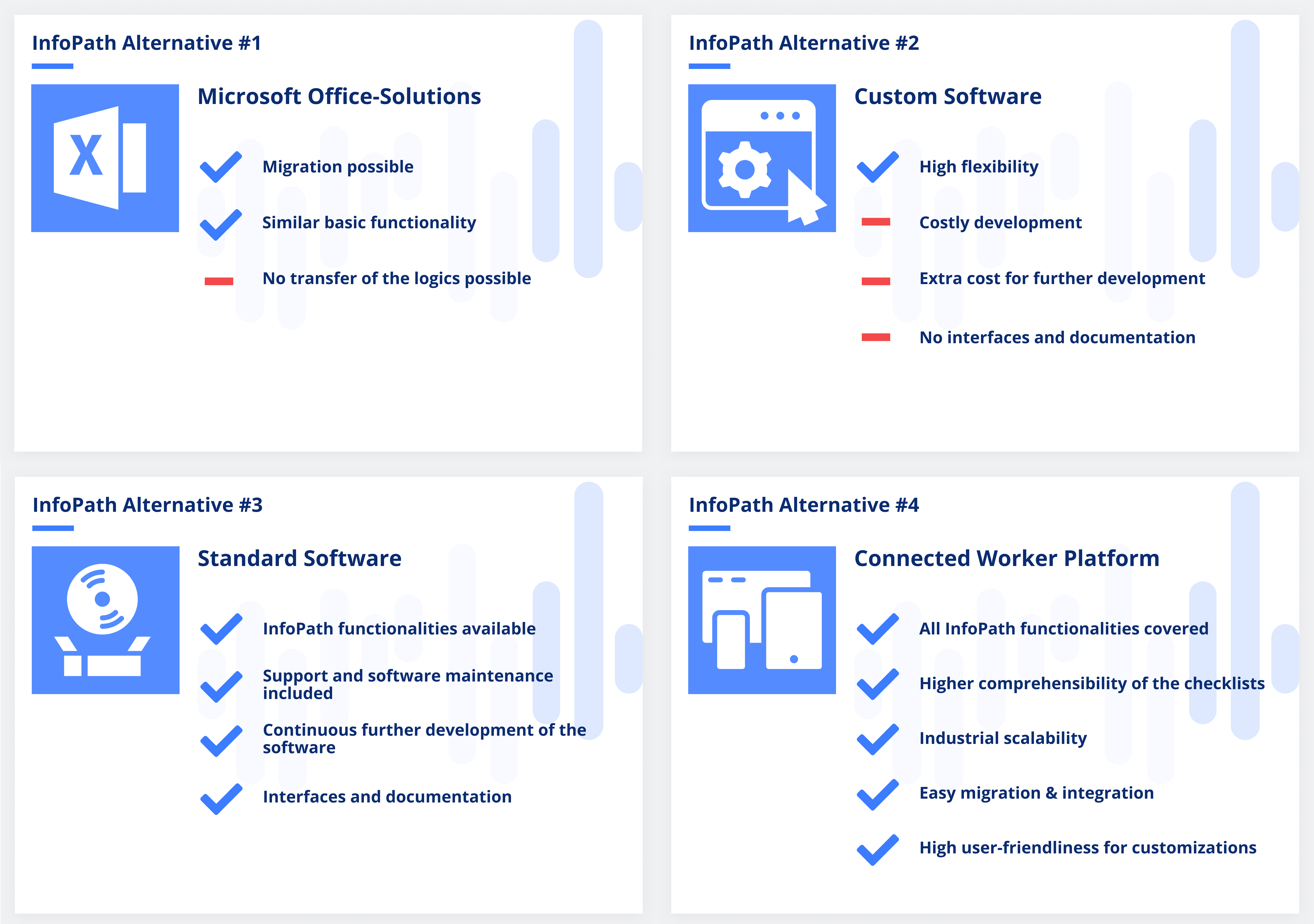What it's about
In this article, we look at what options are available for MS InfoPath users. We take a look at the functionalities of the application, which is popular in the industrial environment, and explain how a Connected Worker Platform can be a real alternative for the program that is being phased out.
Microsoft InfoPath Successor: Which Software is the best InfoPath Alternative?
It is impossible to imagine our everyday working life without Microsoft Office. According to Statista, the market share in the office software segment is currently 85%. MS Office products are used in various business areas and perform very well there. MS Office solutions are also popular in the industrial context, for example in production or quality management. When it comes to checklists, test protocols or forms, Microsoft InfoPath was often used as a solution. Microsoft has decided to discontinue the main support for InfoPath from 13.07.2021. On this occasion, I would like to discuss the following questions in this blog post about it:
1. What is the functionality of Microsoft InfoPath?
2. How is InfoPath used in the industrial environment?
3. What alternatives are there to MS InfoPath?
4. What are the reasons for using dynamic checklist software as an InfoPath alternative?
In recent years, I have been able to visit many of our customers on site in the production hall. I have been shown machines, production lines, software solutions and other elements of production. In most cases, I have seen industrial companies using MS Office solutions on the shop floor as well. I noticed that a lot of companies used InfoPath for creating inspection protocols or maintenance checklists.. But why is an apparent office solution used in production? And what is the best InfoPath alternative as a successor to InfoPath? To answer this question, it's important to understand Microsoft InfoPath's functionality first.
1. What functionality does InfoPath offer?
InfoPath is an application program from Microsoft that enables both the design of XML-based forms and their subsequent filling with information. The created InfoPath forms can be distributed online over a network, so that information from local users can be easily collected and stored. InfoPath can also be used in conjunction with SharePoint Services to make forms available to users.
Since InfoPath is chargeable for designing as well as filling out the forms, the target group is essentially limited to companies. These companies should be enabled to integrate forms into workflows. As of InfoPath 2007, it is also possible, in conjunction with the Office SharePoint Server, to place the forms on the Web using the “Forms Services”. These can then be filled out and submitted by the end user even without an InfoPath installation.
2. How is InfoPath used in the industrial environment?
In the industrial environment, InfoPath is primarily used for inspection records, maintenance checklists, acceptance records and service checklists.
InfoPath users can create these documents or forms in an editor and then use them in the production environment. InfoPath is characterized primarily by the fact that individual logics can be incorporated into these documents. Similar to Excel wsith its formulas and Visual Basic editor, InfoPath also offers the possibility to implement formulas and code. InfoPath uses three different technologies for this purpose:
Using XML, documents can be created in a standardized format. XML is like a construction manual that contains information about content, structure and formats. Similar to CSV or JSON, XML is an absolute standard format and is therefore characterized by easy migrations and widespread know-how.
C# code can be used to map logics in documents and set up documents in an automated way. For example, a form field could be locked when a certain value is placed in an adjacent field. C# is widely used, but not very easy to learn.
Visual Basic (VBA) is a programming language that can be used in Excel as well as InfoPath. Originally used in Microsoft operating systems, it is now mostly associated with Excel. VBA can also be used to implement individual logics in InfoPath. The disadvantage is that these logics can only be used in the Microsoft environment, since VBA is not used outside of Microsoft software.
Despite or often even because of the individualization and configuration possibilities in InfoPath, the use in the productive environment is mostly characterized by media breaks and process gaps, blindspots in programming and lack of extensibility and maintainability.
InfoPath offers the possibility to implement logics in documents through C# and VBA. However, the possibility of integrating InfoPath itself into process flows through interfaces and integrated workflows is missing, without creating media discontinuities or process gaps.
Individual programming can bring an important benefit to the company, but on the other hand, it harbors an enormous potential for error. Individual programming can quickly end up in blind spots: “Who wrote this code? Where does this logic come from? Why does the checkpoint change when I enter a value? I don’t understand what’s supposed to happen here in this form?”
These are questions I’ve heard frequently when it comes to InfoPath documents with custom programming.
It’s not just comprehending and understanding the logic that can be difficult. Maintaining and evolving InfoPath documents is also complicated by complex programming and blindspots that have developed. A missing versioning system poses risks for productive operations, since maintenance errors or incorrect further developments of documents and forms can have a direct influence on the use of the documents and thus on the operational processes.
3. What are the alternatives to MS InfoPath?
Microsoft has officially announced the end of InfoPath with the discontinuation of support. Now alternatives and the right InfoPath successor have to be found to enable secure and robust work in the future. Alternatives for InfoPath are plentiful and can be grouped into the following categories:
Other Microsoft Office solutions
The Microsoft ecosystem offers alternatives such as Excel or Forms, which provide similar functionality to InfoPath and also offer data migration options. In Microsoft Excel, XML checklists can be migrated. Logics that were previously built in InfoPath cannot be migrated directly, but can be replaced in Excel using VBA.
Custom software
Almost any required function for various use cases can theoretically be solved using custom software. If a concrete problem exists, which is to be solved by software, system houses or software agencies step to the start, in order to program software individually. The individually programmed software exhibits however explicit restrictions:
Costly development of the software, since from proverbial zero one begins.
Further developments and adjustments hold high hidden costs.
Interfaces and documentation are not initially available.
Standard software
The best InfoPath replacement is standard software. They come with a concrete set of functions that are constantly being improved and developed. In addition, support and troubleshooting for standard software are usually basic components of the product and are therefore included. Interfaces and documentation of the technologies used are also usually part of the product. Sensible alternatives here are, for example, Typeform for simple, clear forms or Google Forms for simple checklists and protocols. Tools such as ClaySys give the user the additional option of integrating logics and small code modules into structured documents and forms.
4. What are the reasons for using dynamic checklist software as an InfoPath alternative?
The listed software categories all make sense as alternatives for InfoPath. Most of the standard software is light on its feet and shines above all through simplicity and a standard set of functionality. MS Office solutions such as Excel or Forms are easy to migrate and can map complex logic with VBA knowledge. Custom software can often solve use cases and related problems to be solved very pointedly and precisely. However, custom software comes with high acquisition costs and difficult and costly further development. All three solution categories have specific advantages and disadvantages, but none of them address the missing building blocks of the InfoPath solution with respect to industrial requirements. As explained above, InfoPath also comes with inherent difficulties when used in production-related use cases. Media discontinuities and process gaps as well as blind spots in programming logics are examples. To adequately address these weaknesses, a new, intelligent solution is needed that combines the advantages of MS InfoPath with functionalities that solve concrete requirements of industrial companies. A software like Operations1 can solve these requirements through a versatile range of functions and through a software architecture that can be integrated end-to-end. Thus, there are a number of arguments in favor of using a Connected Worker Platform as a Microsoft InfoPath successor:
All basic functionalities are covered.
The comprehensibility for operational employees increases enormously through the integration of media such as images and videos (dynamically integrable from external systems).
A Connected Worker Platform is industrially scalable, for example through a built-in versioning and revision system, structure classes and persistent IDs.
Changing InfoPath is very easy due to automatic migration of existing XML or JSON data into the software.
Due to the no-code principle, adaptations to checklists and test protocols can be carried out easily and quickly.

Conclusion
A number of InfoPath alternatives exist on the market and in various software categories. Many solutions offer sufficient functionality to dynamically replace InfoPath in simple use cases. However, when it comes to making technological progress in migrating from InfoPath to a successor and solving problems in industrial use cases software-wise, many of these solutions fail.
It takes an adaptive solution to take the next step and provide a new, comprehensive approach to solving problems.
If you want to learn how checklists and protcollectors can be used dynamically in industry, I recommend reading our e-paper on Checklist 4.0.
Checklist 4.0
With digital checklists, you increase efficiency and make better decisions. Read in our whitepaper how our software solution can help you!
Benjamin Brockmann
Benjamin Brockmann (M. Sc., Management & Technology) founded Operations1 in 2017 together with Daniel Grobe (also M. Sc., Management & Technology). The founders developed the software solution based on various practical projects, including at the Fraunhofer Institute, and on their experience in industry, auditing and management consulting. Benjamin Brockmann has already worked for companies such as KPMG and Arthur D. Little.



